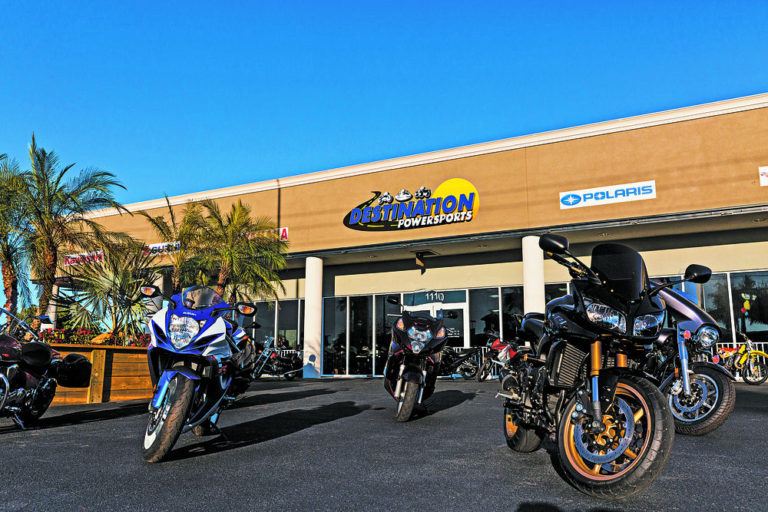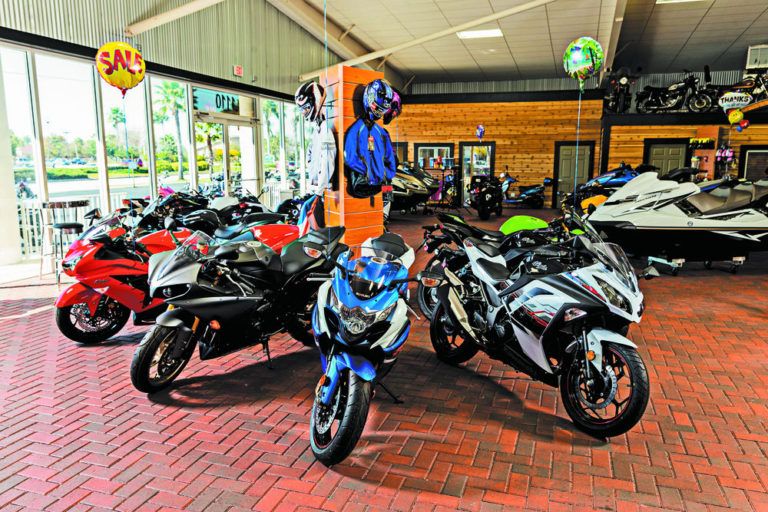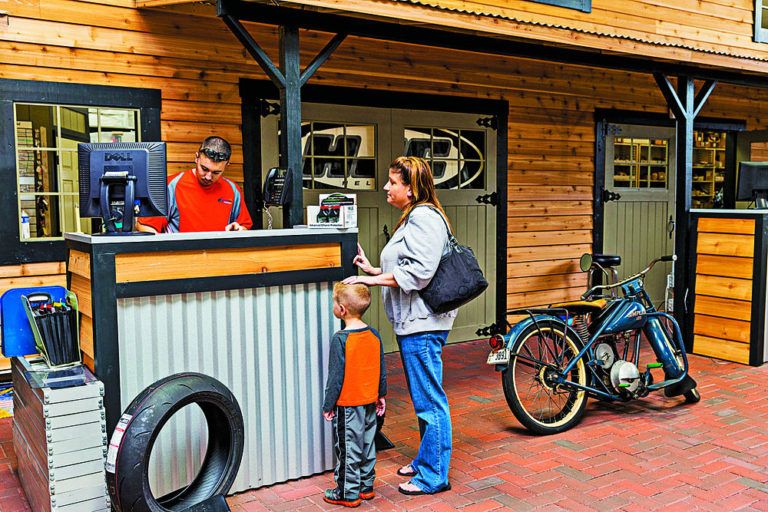IT IS ALWAYS exciting to move into a new house, but it’s not always easy. If it is a new home for your dealership, the move can cost a lot of money, if you’re not careful.
Just ask Bill Shenk, co-owner of the Destination Powersports Dealer LAB dealership in Punta Gorda, Fla., and owner of the 20 Group consultancy, PowerHouse Dealer Services.
 In December, Shenk and his crew of 15 employees moved Destination Powersports to a new facility on a corner lot with 400 feet of frontage on U.S. 41, a main route through Florida. The 13,000-sq. ft. building is 130 feet wide in the front. The new location provides better visibility, a better outside display area, a more efficient and attractive service center and customer lounge, and a more effective layout for marketing parts, accessories and units.
In December, Shenk and his crew of 15 employees moved Destination Powersports to a new facility on a corner lot with 400 feet of frontage on U.S. 41, a main route through Florida. The 13,000-sq. ft. building is 130 feet wide in the front. The new location provides better visibility, a better outside display area, a more efficient and attractive service center and customer lounge, and a more effective layout for marketing parts, accessories and units.
About 6,000 vehicles drive past the new building each day. At the former facility, a 6,250 sq. ft. building on a half-acre on a dead-end street one block off U.S. 41, about 20 cars drove past daily.
The old facility had outside display space for about 30 vehicles, and accommodated eight customer parking spaces.
“We have 20 spaces marked, but could park 100 customer cars and still have our display units out if need be,” Shenk said.
Photos by Edward Linsmier
It was a long ramp-up. Shenk started working on the deal in the fall of 2010, made his first offer in 2011 and closed Aug. 30. Remodeling began Sept. 3 and the first day of business was Dec. 4.
“Negotiating the purchase took longer than we expected, as did the city permits and selecting contractors,” he said, “so we didn’t get moved until December, during our holiday sales season, and that hurt our December sales. Initially, we had expected to move during September.”
Shenk estimates the new location should boost the dealership’s 2014 revenues by about 25 percent, to about $8 million, everything else being equal. Gross profit and net income are expected to grow proportionally.
 So having worked through this move — and several other dealership expansions — what has Shenk learned? “You have to remain flexible. Realize that surprises are going to happen and be prepared to deal with them as they occur.”
So having worked through this move — and several other dealership expansions — what has Shenk learned? “You have to remain flexible. Realize that surprises are going to happen and be prepared to deal with them as they occur.”
WHAT EVERY DEALER SHOULD KNOW
Shenk lists 10 potential problems and ways to deal with them when you expand or relocate your dealership.
CONTROL YOUR TEAM and keep them focused on the main task: keeping your customers happy. Your team will be enthusiastic and excited about their new home; as a result, your employees will want to share their ideas and, as a result, will naturally take their eye off the ball. Moving takes a tremendous amount of time. Employees must understand that it’s not their move,and you may not have the time or the energy to listen to their suggestions, Shenk said.
“I didn’t even show them the plan,” he noted. “The most important thing they could do was stay focused on the daily business and work as hard as they can. That’s the key.”
MANUFACTURERS WILL BE INVOLVED. OEMs will ask more of you, Shenk said, so be prepared for the extra work. The OEMs will want you to order product — not just motorcycles, but also parts and accessories. “They’ll see the store move/expansion as a great opportunity and will want to ship the stuff right away,” he said. “But that’s the last thing you want: more clutter to deal with and take care of.”
There will be lots of paperwork from each of your OEM partners, and they’ll want lots of details on the new facility. “The paperwork isn’t hard, it’s very easy to do, but it takes time and that’s something you don’t have during a move,” Shenk noted. “One OEM held up approval one month, and it cost us $18,000 because of costs [running] two sites. We also lost about $10,000 in gross profit because we couldn’t sell vehicles. That stuff can get real expensive, real fast.”
DON’T BURN OUT THE TEAM. There will be lots of extra dealership-specific work to do, and you can’t really bring in extra help. From the outside it might look like fun, but there are hundreds of thousands of dollars in computer systems, and machines and parts that have to be moved and accounted for. And you have to continue to do business. “There’s nobody you can hire to move these items, because no moving service I’m aware of knows what to do with or how to safely move units, PAC, special tools etc. You have to depend on your existing team,” Shenk said.
Staff will want to put in the extra hours but can get tired as a result; pretty soon their focus on the customer will slip. Pace them and watch for signs that customer service is slipping, then make adjustments, Shenk noted.
Continued
MAINTAIN CUSTOMER CONTACT. During a relocation it is easy to stop doing the proactive things that make you successful, like follow-up phone calls, emails and other customer contact processes. Place a premium on continuing these processes without a drop in quality.

OTIFY YOUR SUPPLIERS.
“It’s amazing how many suppliers you have, and you have to deal with each one individually so your supplies go to the new location and the billing goes there, too,” Shenk said. “We have more than 30 suppliers, and we had to sit down and call each one and then FAX the changes. It’s not difficult, but you have to recognize the problem and plan to deal with it in a systematic way.”
REMEMBER YOU’RE RUNNING TWO LOCATIONS, TEMPORARILY. In reality you won’t be running two operations — you’ll be running one operation scattered across two locations for a month or more, Shenk noted. It can be more difficult to get simple things done in this scenario.
“One of the biggest problems is dealing with your best customers who drop in to talk about the new store. They don’t come to buy, they come because they’re excited and it’s a new toy store and they want to talk about it, and they’ll tell you about other dealerships they’ve seen,” Shenk said. “You don’t want to alienate them, but you can burn 15 minutes in a heartbeat. It’s especially bad when they come in during construction and just want to talk. If you’re in a retirement community, like we are, it’s even worse. So be prepared for it.
“One of our good customers dropped off a vehicle for service at one location, and it got worked on at the other location. We got the work done but we didn’t keep him informed; it was not the level of service he expected from us. He’s stayed with us, but we could have lost a good customer.”
NORMAL STAFF PROBLEMS BECOME EXAGGERATED. When everyone’s tired, it causes more friction between departments and people. A store move “really highlights the work ethic of the team,” Shenk said. “We had a push on to move 100 vehicles one evening, and then service wanted to know why nobody was helping them. Like who could help move all the manuals and tools and parts?”
OUTSIDE EVENTS GET IN THE WAY. Shenk, as an owner, actually closed on a second dealership in another state on Oct. 1. “It was exhausting to do the two things at once, but you can’t schedule opportunity — you take it when it comes,” he said. “At the same time, our DMS went down and we had to replace our server. That’s traumatic under normal circumstances. We were down a full day.” The best-laid plans don’t always work, so be prepared to develop and go to a Plan B.
CONSTRUCTION PROBLEMS WILL OCCUR. OEMs, for example, may want concessions from the city for signage and other components. You can get caught in the middle. “One OEM wanted a bigger sign than our maximum sign allocation would allow if we gave every one of our OEM partners the same amount of signage, and it continues to be a problem,” Shenk said. A new challenge is a municipal prohibition on storing crates outside. “That totally changes how much storage we have,” he added.
NEGOTIATION AND PURCHASING DELAYS WILL HAPPEN. “This was a huge problem for us because delays pushed the deal into our busy season,” Shenk noted. “We started diligently in the spring but it took several extra months to get the deal at a price that would work for us. Then, the proper use approval from the city took more time. And it took another 90 days to get funding for the project after we signed the purchase contract. That put us into our busy season and made the move doubly difficult.” Shenk reminds dealers to remain flexible and be prepared to adjust.